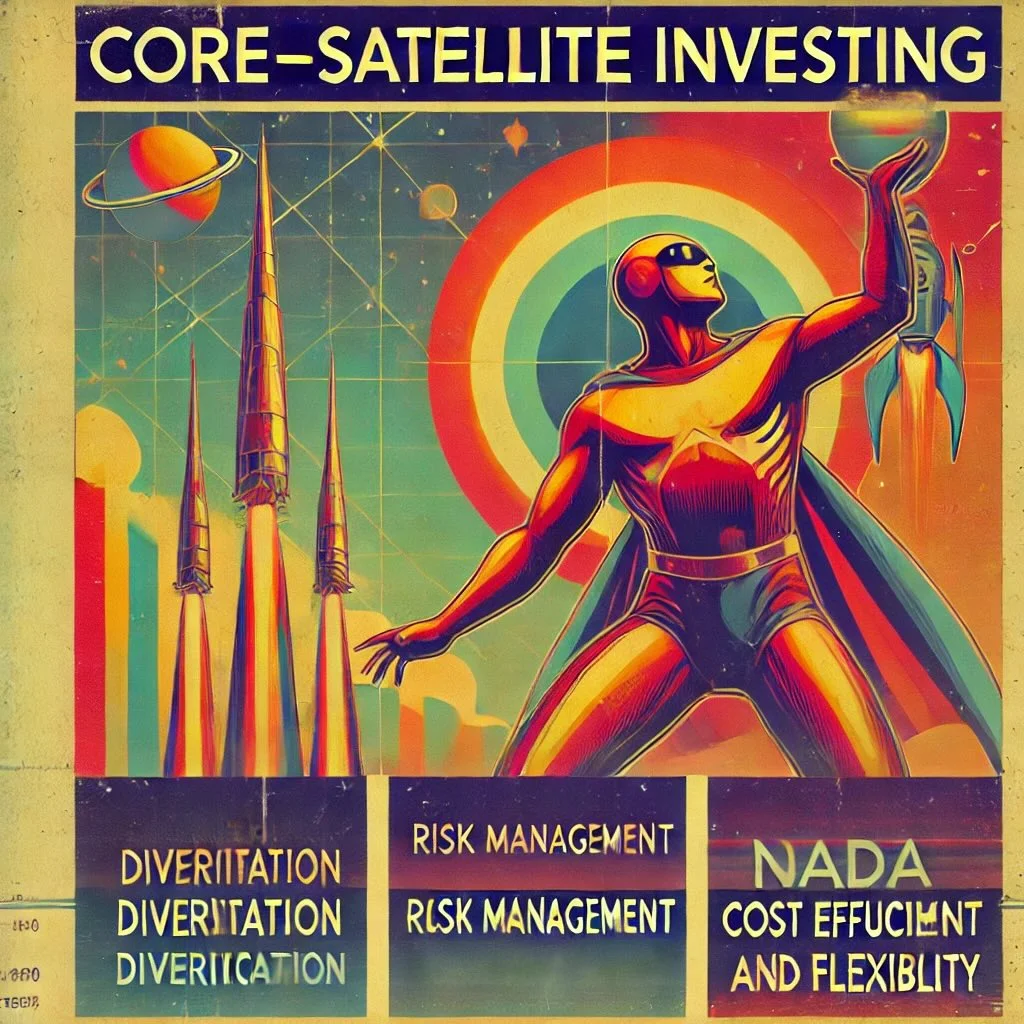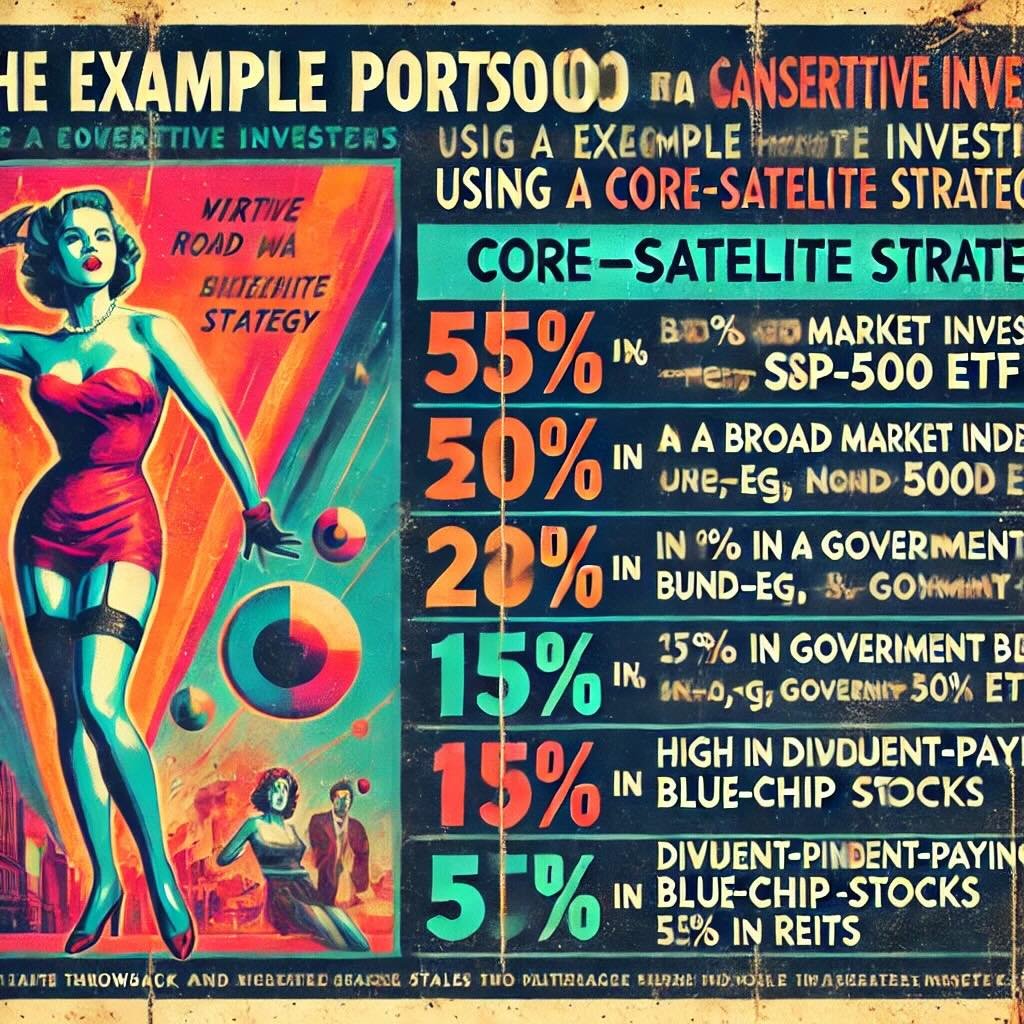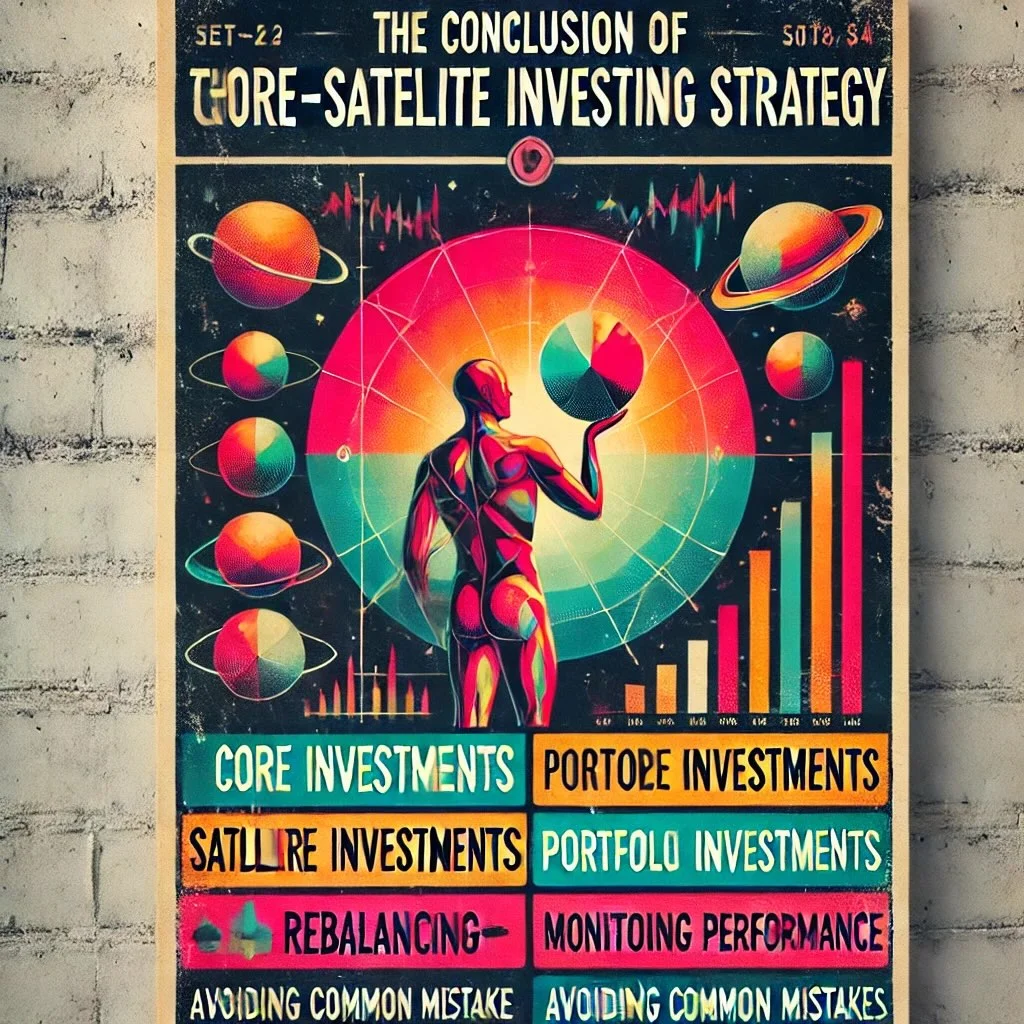Investing doesn’t have to be a stressful rollercoaster. Enter the core-satellite approach, a strategy that’s been gaining traction among savvy investors. Think of it as building a sturdy ship with a powerful engine at its core and smaller, agile sails to catch extra wind. The core is made up of broad, stable investments that provide a solid foundation, while the satellites are more targeted, higher-risk assets that offer growth potential. This blend helps balance stability and growth, making it easier to navigate the choppy waters of the financial markets.
source: Dividend Growth Investing on YouTube
Overview of a Core-Satellite Approach
So, why are we here? The goal of this article is to demystify the core-satellite strategy and show you how to implement it in your own portfolio. Whether you’re a seasoned investor or just starting out, understanding this approach can help you optimize your investments for better returns and lower risk. We’ll walk you through the basics, benefits, and steps to create a balanced, resilient portfolio. Ready to build your investment strategy like a pro? Let’s dive in!

Understanding Core-Satellite Investing
Definition
Core-satellite investing is like crafting a masterpiece with a sturdy base and unique, eye-catching details. At its heart, this strategy combines the stability of broad, diversified investments (the core) with the potential high returns from more targeted, riskier investments (the satellites). It’s a way to balance the safety of dependable returns with the excitement of chasing growth opportunities.
Components
Core Investments
The core of your portfolio is the foundation, the bedrock that holds everything steady. These investments are broad, diversified, and stable. Think of low-cost index funds, ETFs, or broad mutual funds that track major market indices like the S&P 500. The idea is to cover a wide range of assets to minimize risk and ensure steady growth. These core investments usually make up the bulk of your portfolio—about 70% to 90%. They provide the dependable, long-term returns that keep your investment ship on course, even in choppy waters.
- Low-Cost Index Funds: These are funds that track a specific market index. They offer broad market exposure at a low cost, making them ideal for the core part of your portfolio.
- ETFs (Exchange-traded Funds): Similar to index funds but traded like stocks, ETFs offer flexibility and diversification.
- Broad Mutual Funds: These funds invest in a wide range of assets, providing stability and reducing risk.
Satellite Investments
Now, let’s add some flair with satellite investments. These are the smaller, more aggressive parts of your portfolio—typically making up 10% to 30%. Satellites are where you take calculated risks to enhance returns. These can be sector-specific funds, individual stocks, or alternative investments like commodities or real estate. The goal here is to outperform the market and boost your overall returns. Satellites can be more volatile, but they offer the potential for higher growth, adding a dynamic edge to your portfolio.
- Sector-Specific Funds: Invest in particular sectors of the economy, like technology, healthcare, or energy. These funds can capture growth in specific areas.
- Individual Stocks: Handpick stocks of companies you believe have strong growth potential. This requires more research but can pay off significantly.
- Alternative Investments: Explore non-traditional assets like managed futures, commodities, real estate, or cryptocurrencies. These can diversify your portfolio and offer unique growth opportunities.

Benefits of Core-Satellite Investing
Diversification
Diversification is the secret sauce of investing, and core-satellite investing dishes it out in spades. By spreading your investments across a wide range of assets, you reduce the risk of any single investment tanking your entire portfolio. The core investments are your broad, diversified base, capturing the steady performance of the entire market. Think index funds and ETFs that cover multiple sectors and industries. Then, you sprinkle in satellite investments, which are more targeted and specialized. This blend means you’re not putting all your eggs in one basket, but rather in many baskets spread across a range of fields. Diversification helps cushion against market volatility, ensuring smoother sailing in both calm and stormy markets.
Risk Management
Balancing risk and reward is the name of the game, and core-satellite investing excels at it. Your core investments act as the stabilizers, providing a reliable foundation. These are typically low-risk assets that grow steadily over time. On the flip side, your satellite investments are the thrill-seekers, offering higher potential returns but with more risk. This setup allows you to take advantage of growth opportunities without jeopardizing the overall stability of your portfolio. It’s like having a rock-solid ship with a few speedboats ready to chase exciting new ventures.
Cost Efficiency
One of the best things about the core-satellite approach is its cost efficiency. Core investments, such as index funds and ETFs, are known for their low expense ratios. These low-cost options keep more of your money working for you, rather than paying for high fees. By anchoring your portfolio with these economical choices, you free up resources to invest in more speculative satellite options. Essentially, you get the best of both worlds: cost-effective stability and the freedom to explore higher-cost, higher-return opportunities with your satellite investments.
Flexibility
Markets are constantly changing, and so should your investment strategy. The core-satellite approach offers the flexibility to adapt to market conditions and seize opportunities. While your core investments remain the steady bedrock of your portfolio, you can tweak your satellite investments based on market trends, economic forecasts, or personal interests. Maybe tech stocks are booming, or you’ve spotted a promising startup—your satellite portion allows you to pivot and capitalize on these trends without overhauling your entire portfolio. This flexibility ensures your investments stay aligned with your financial goals and the evolving market landscape.

Building the Core
Asset Selection
Selecting the right core assets is crucial for the foundation of your portfolio. The goal here is to choose investments that provide broad market exposure, stability, and low costs. Here are some key types of assets to consider:
- Index Funds: These funds aim to replicate the performance of a specific index, like the S&P 500. They offer a simple way to invest in a wide array of companies with a single purchase. Index funds are known for their low fees and broad diversification, making them ideal for the core of your portfolio.
- ETFs (Exchange-Traded Funds): Similar to index funds, ETFs are collections of securities that track an index, sector, commodity, or other asset. They trade like stocks on an exchange, providing flexibility and liquidity. ETFs can be a cost-effective way to achieve diversification.
- Broad Mutual Funds: These funds invest in a wide range of securities, offering diversification across different sectors and industries. They can be actively or passively managed. While actively managed funds may have higher fees, they can provide additional strategic advantages.
Criteria for Core Investments
When selecting core investments, it’s essential to focus on assets that align with the following key criteria:
- Low Cost: Keeping expenses low is a fundamental aspect of core investments. High fees can eat into your returns over time. Look for investments with low expense ratios. Index funds and ETFs are typically cost-efficient choices because they require less active management.
- Broad Diversification: Diversification helps spread risk by investing across various sectors, industries, and geographic regions. This reduces the impact of poor performance in any single area. Core investments should provide broad market exposure, capturing the performance of many different companies and industries.
- Stability: The core of your portfolio should offer steady, reliable growth. These investments are less volatile and more predictable, providing a solid foundation. Look for established funds with a long track record of stable returns. They should be less susceptible to dramatic market swings.

Selecting Satellite Investments
Types of Satellite Investments
Once you’ve built a sturdy core, it’s time to add some dynamic satellite investments to the mix. These are the investments that can potentially supercharge your returns, albeit with a bit more risk. Let’s explore the various types of satellite investments you can consider:
- Sector-Specific Funds: These funds focus on specific sectors like technology, healthcare, or energy. They allow you to capitalize on growth trends in particular areas of the economy. For example, if you believe the tech sector will outperform, investing in a tech-specific fund could be a savvy move.
- Individual Stocks: Picking individual stocks offers the chance to invest in companies you believe have strong growth potential. This requires more research and can be riskier, but the rewards can be significant. Think of companies in emerging industries or those with innovative products and services.
- Alternative Investments: These include assets like real estate, commodities, or even cryptocurrencies. Alternative investments can add a unique dimension to your portfolio, offering diversification beyond traditional stocks and bonds. They can be particularly appealing if you have a high-risk tolerance and seek exposure to non-traditional asset classes.
Criteria for Satellite Investments
Choosing the right satellite investments involves more than just picking the latest hot stock. Here’s what to consider:
- Growth Potential: Look for investments with strong growth prospects. This could be in sectors that are expanding rapidly or companies with innovative products. Analyze market trends and company fundamentals to gauge potential.
- Market Trends: Keep an eye on broader market trends. For example, renewable energy is gaining traction, making clean energy stocks and funds attractive. Similarly, advancements in technology continually create opportunities in the tech sector.
- Risk Tolerance: Your risk tolerance should guide your satellite investment choices. If you’re risk-averse, you might opt for less volatile sectors or blue-chip stocks. If you’re more of a risk-taker, you could explore high-growth startups or alternative assets like cryptocurrencies.
Balancing the Portfolio
Balancing your core and satellite components is crucial to maintaining your desired risk and return levels. Here’s how to strike the right balance:
- Allocation: Typically, your core investments should make up about 70% to 90% of your portfolio, providing stability and steady growth. The remaining 10% to 30% can be allocated to satellite investments, adding a layer of potential high returns.
- Rebalancing: Regularly review and adjust your portfolio to maintain the balance between core and satellite investments. Market conditions change, and so should your allocation. If your satellite investments have performed exceptionally well and now make up a larger portion of your portfolio, consider rebalancing to reduce risk.
- Diversification: Ensure that both your core and satellite investments are diversified. Avoid putting all your satellite investments in one sector or asset class. Spread them across various areas to mitigate risk.
- Performance Monitoring: Keep a close eye on the performance of your satellite investments. If an investment is underperforming consistently, don’t hesitate to reassess and make changes. Flexibility is key to optimizing your portfolio’s performance.

Implementing the Strategy
Portfolio Allocation
Getting your portfolio allocation right is the first step to successful core-satellite investing. The idea is to strike a balance that aligns with your financial goals and risk tolerance. Generally, you’ll want to allocate 70% to 90% of your portfolio to core investments. These are your low-cost, diversified assets like index funds and ETFs that provide steady, reliable returns.
The remaining 10% to 30% goes to satellite investments. These are your high-risk, high-reward assets that can boost your overall returns. This mix allows you to take advantage of growth opportunities without jeopardizing the stability of your portfolio. The exact percentages will depend on your individual risk tolerance and investment goals. Are you more conservative? Lean towards 90% core. Feeling adventurous? You might go for a 70% core and 30% satellite split.
Rebalancing
Markets move, and so should your portfolio. Regular rebalancing is crucial to maintaining your desired allocation and managing risk. Over time, some of your satellite investments might outperform and grow faster than your core, skewing your portfolio balance. Rebalancing involves selling some of your high-performing assets and buying more of the underperforming ones to bring your portfolio back to its original allocation.
Why Rebalance? Rebalancing helps you lock in gains from high-performing investments and ensures you’re not overexposed to any single asset or sector. It’s a disciplined approach to managing risk and keeping your investment strategy on track. Aim to rebalance your portfolio at least once a year, or more frequently if market conditions change significantly.
Monitoring Performance
Keeping an eye on the performance of your investments is essential. Regularly monitor both your core and satellite investments to ensure they’re performing as expected and contributing to your financial goals.
Core Investments: These should be the steady performers in your portfolio. Check that they’re providing the stable returns you expect. If a core investment consistently underperforms, it might be time to reassess its place in your portfolio.
Satellite Investments: These require closer scrutiny due to their higher risk. Track their performance regularly and be prepared to make adjustments if they’re not meeting your growth expectations. Don’t be afraid to cut your losses if a satellite investment isn’t panning out as planned.
Tools for Monitoring: Use investment platforms and apps that offer portfolio tracking features. Set up alerts for significant changes in your investments’ performance. Regular reviews, whether monthly or quarterly, can help you stay on top of your portfolio’s health.

Practical Examples
Example Portfolios
Let’s dive into some example portfolios to see how a core-satellite strategy can work for different types of investors. Each portfolio is tailored to a specific risk tolerance and investment style.
Conservative Investor
For the conservative investor, the focus is on stability and low risk. Here’s a sample allocation:
- Core Investments (85%):
- 50% in a broad market index fund (e.g., S&P 500 ETF)
- 20% in government bonds
- 15% in high-quality corporate bonds
- Satellite Investments (15%):
- 10% in dividend-paying blue-chip stocks
- 5% in real estate investment trusts (REITs)
This portfolio prioritizes steady income and capital preservation, with a small portion allocated to growth through high-quality stocks and REITs.
Balanced Investor
A balanced investor seeks a mix of stability and growth. Here’s how they might allocate their portfolio:
- Core Investments (75%):
- 40% in a total stock market index fund
- 25% in a mix of government and corporate bonds
- 10% in international index funds
- Satellite Investments (25%):
- 10% in sector-specific ETFs (e.g., technology, healthcare)
- 10% in high-growth individual stocks
- 5% in commodities like gold or silver
This portfolio aims to capture broad market growth while taking calculated risks in specific sectors and individual stocks.
Aggressive Investor
The aggressive investor is all about high growth and is willing to take on more risk. Here’s a potential allocation:
- Core Investments (70%):
- 50% in a total stock market index fund
- 10% in international index funds
- 10% in high-yield bonds
- Satellite Investments (30%):
- 15% in emerging markets stocks
- 10% in tech startups or speculative stocks
- 5% in alternative investments like cryptocurrencies
This portfolio leans heavily towards equities and high-risk assets, aiming for maximum growth potential.
Case Studies
Case Study 1: Jane the Conservative Investor
Jane, a 60-year-old retiree, wanted to protect her savings while earning a modest return. She implemented a core-satellite strategy with 85% in core investments and 15% in satellite investments. Her core was comprised of a mix of index funds and bonds, providing her with steady income and stability. For her satellites, she chose dividend-paying stocks and REITs. Over five years, Jane enjoyed consistent returns with minimal volatility, allowing her to maintain her lifestyle comfortably in retirement.
Case Study 2: Mike the Balanced Investor
Mike, a 40-year-old professional, sought both growth and stability. He allocated 75% of his portfolio to core investments, including total stock market index funds and bonds, with a small portion in international funds. For his satellites, he picked sector-specific ETFs and individual high-growth stocks. This strategy allowed Mike to capitalize on market growth while managing risk. Over a decade, Mike’s portfolio outperformed the market average, giving him a solid foundation for his future financial goals.
Case Study 3: Emma the Aggressive Investor
Emma, a 30-year-old entrepreneur, was all about taking risks for high rewards. She went with a 70/30 core-satellite split. Her core included total stock market and international index funds, along with some high-yield bonds. For her satellites, Emma invested in emerging markets, tech startups, and even some cryptocurrencies. While her portfolio experienced higher volatility, the aggressive approach paid off with substantial gains, significantly boosting her net worth over seven years.

Common Mistakes to Avoid
Overweighting Satellites
It’s tempting to chase high returns by loading up on exciting, high-risk satellite investments. However, overweighting satellites can throw your portfolio out of balance and expose you to unnecessary risk. Remember, satellites are meant to complement your core, not dominate it.
Why It’s Risky: Allocating too much to satellites can lead to significant volatility. These investments, while potentially rewarding, are also more susceptible to market swings. If the market turns against you, an overweighted satellite portfolio can suffer heavy losses, undermining the stability provided by your core investments.
How to Avoid It: Stick to your predetermined allocation. Typically, this means keeping satellites at 10% to 30% of your total portfolio. Regularly review your portfolio to ensure your satellite allocation hasn’t grown disproportionately due to market movements or new investments.
Neglecting Rebalancing
Rebalancing isn’t the most glamorous part of investing, but it’s crucial for maintaining your portfolio’s health. Over time, the value of your investments will change, causing your allocation to drift from your original plan.
Why It’s Important: Without regular rebalancing, your portfolio can become skewed, increasing risk. For example, if your satellite investments perform exceptionally well, they might grow to represent a larger portion of your portfolio than intended, exposing you to more volatility.
How to Avoid It: Set a schedule for regular rebalancing—quarterly or annually works well for most investors. During rebalancing, sell a portion of the overperforming investments and buy more of the underperforming ones to bring your portfolio back to its target allocation. This disciplined approach ensures you’re not taking on more risk than you’re comfortable with.
Ignoring Costs
Investment costs can quietly erode your returns over time, especially if you’re not paying attention. While core investments like index funds and ETFs typically have low fees, satellite investments can come with higher costs.
Why Costs Matter: High fees can significantly reduce your net returns. For example, actively managed funds or niche ETFs often carry higher expense ratios. Trading costs for individual stocks and alternative investments can also add up quickly, eating into your gains.
How to Avoid It: Always check the expense ratios and fees associated with your investments. Opt for low-cost options whenever possible, particularly for your core investments. For satellites, weigh the potential returns against the costs to ensure the investment is worth it. Use tools and platforms that offer low-cost trading and avoid frequent trading to minimize costs.

12-Question FAQ: How to Use a Core-Satellite Approach in Investing
1) What is core-satellite investing?
A portfolio framework where a low-cost, diversified “core” (≈70–90%) delivers market-like returns and stability, while “satellites” (≈10–30%) are targeted, higher-risk ideas aimed at boosting return or diversification.
2) Why use it instead of a single fund?
It blends simplicity + stability (core index exposure) with flexibility (tactical or thematic satellites), helping you manage risk, costs, and taxes while still pursuing excess returns.
3) What goes in the core?
Broad, cheap, diversified exposures such as total-market equity/bond index funds, global market-cap ETFs, and broad mutual funds with low expense ratios.
4) What counts as a satellite?
Targeted positions: sector/thematic ETFs, individual stocks, factor tilts (value, momentum, quality), international/emerging tilts, or alternatives (REITs, commodities, managed futures, even a small crypto sleeve if appropriate).
5) How do I size core vs satellites?
Match to risk tolerance and goals:
Conservative: 85–90% core / 10–15% satellites
Balanced: 75–80% core / 20–25% satellites
Aggressive: 70% core / 30% satellites
6) How do I pick core funds?
Prioritize low fees, broad diversification, and liquidity. Examples: total U.S. equity, total international equity, and aggregate bond index funds/ETFs. Keep the number of core funds small (2–5 usually suffices).
7) How do I choose satellites?
Use clear theses: growth potential, mispricing, factor exposure, or diversifier role (low correlation to core). Define entry criteria, sizing (usually 1–5% each), a time horizon, and exit rules upfront.
8) How often should I rebalance?
Set a cadence (annual or semiannual) and/or tolerance bands (e.g., rebalance when an asset drifts ±20% of its target weight or ±2–3 percentage points). Rebalancing trims winners, tops up laggards, and restores risk.
9) How do I control costs and taxes?
Anchor costs with low-expense-ratio core; limit turnover in satellites; use tax-advantaged accounts where possible; in taxable accounts, consider ETFs, tax-loss harvesting, and lot selection. Avoid fee creep from niche products.
10) How do I monitor success?
Track at least quarterly: total return vs a blended benchmark, risk (volatility, drawdown), tracking difference, satellite hit rate, and whether each satellite still meets its investment thesis.
11) What are common mistakes?
Overweighting satellites (strategy drift and excess volatility)
Neglecting rebalancing
Chasing hot themes without rules
Ignoring fees/taxes that erode edge
Too many positions (diworsification)
12) Can this be adapted over time?
Yes—adjust the core/satellite split with life stage (e.g., raise core and bonds as you near goals), rotate satellites as theses play out, and simplify when time or interest wanes. Keep an IPS (Investment Policy Statement) to guide changes.
Educational content only; not investment advice. Consider personal circumstances or a fiduciary adviser.
Conclusion
We’ve covered a lot of ground in this article, so let’s recap the main points. The core-satellite approach to investing offers a balanced strategy that combines stability with growth potential.
- Core Investments: These are your low-cost, diversified assets that form the stable foundation of your portfolio.
- Satellite Investments: These are the higher-risk, higher-reward assets that add dynamism and potential for increased returns.
- Portfolio Allocation: Typically, 70% to 90% of your portfolio should be in core investments, with the remaining 10% to 30% in satellites.
- Rebalancing: Regularly rebalance your portfolio to maintain your desired allocation and manage risk.
- Monitoring Performance: Keep an eye on both core and satellite investments to ensure they are performing as expected and adjust as necessary.
- Avoid Common Mistakes: Don’t overweight satellites, neglect rebalancing, or ignore investment costs.
Encouragement to Start
Ready to take control of your financial future? The core-satellite approach is a flexible and effective strategy that can help you achieve your investment goals. Start by assessing your risk tolerance and financial objectives. Build your core with reliable, low-cost investments and then add satellites to capture growth opportunities. Remember, the goal is to create a balanced, resilient portfolio that can weather market fluctuations and grow over time.
Final Thoughts
The core-satellite strategy is a powerful tool for both novice and experienced investors. By combining the stability of core investments with the potential of satellite investments, you can create a portfolio that offers steady growth and exciting opportunities. This approach not only manages risk but also allows you to take advantage of market trends and innovations.
Investing is a journey, and the core-satellite strategy can guide you toward your long-term financial goals. Whether you’re looking for steady income, capital appreciation, or a mix of both, this strategy provides a structured yet flexible framework to help you succeed. So, what are you waiting for? Dive in, build your portfolio, and watch your investments grow. Happy investing!
Important Information
Comprehensive Investment Disclaimer:
All content provided on this website (including but not limited to portfolio ideas, fund analyses, investment strategies, commentary on market conditions, and discussions regarding leverage) is strictly for educational, informational, and illustrative purposes only. The information does not constitute financial, investment, tax, accounting, or legal advice. Opinions, strategies, and ideas presented herein represent personal perspectives, are based on independent research and publicly available information, and do not necessarily reflect the views or official positions of any third-party organizations, institutions, or affiliates.
Investing in financial markets inherently carries substantial risks, including but not limited to market volatility, economic uncertainties, geopolitical developments, and liquidity risks. You must be fully aware that there is always the potential for partial or total loss of your principal investment. Additionally, the use of leverage or leveraged financial products significantly increases risk exposure by amplifying both potential gains and potential losses, and thus is not appropriate or advisable for all investors. Using leverage may result in losing more than your initial invested capital, incurring margin calls, experiencing substantial interest costs, or suffering severe financial distress.
Past performance indicators, including historical data, backtesting results, and hypothetical scenarios, should never be viewed as guarantees or reliable predictions of future performance. Any examples provided are purely hypothetical and intended only for illustration purposes. Performance benchmarks, such as market indexes mentioned on this site, are theoretical and are not directly investable. While diligent efforts are made to provide accurate and current information, “Picture Perfect Portfolios” does not warrant, represent, or guarantee the accuracy, completeness, or timeliness of any information provided. Errors, inaccuracies, or outdated information may exist.
Users of this website are strongly encouraged to independently verify all information, conduct comprehensive research and due diligence, and engage with qualified financial, investment, tax, or legal professionals before making any investment or financial decisions. The responsibility for making informed investment decisions rests entirely with the individual. “Picture Perfect Portfolios” explicitly disclaims all liability for any direct, indirect, incidental, special, consequential, or other losses or damages incurred, financial or otherwise, arising out of reliance upon, or use of, any content or information presented on this website.
By accessing, reading, and utilizing the content on this website, you expressly acknowledge, understand, accept, and agree to abide by these terms and conditions. Please consult the full and detailed disclaimer available elsewhere on this website for further clarification and additional important disclosures. Read the complete disclaimer here.




